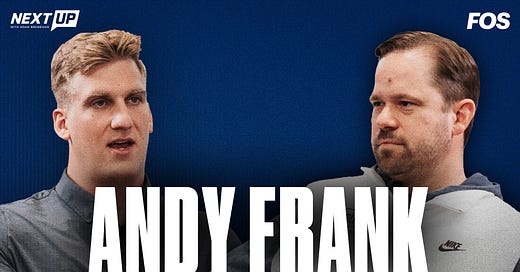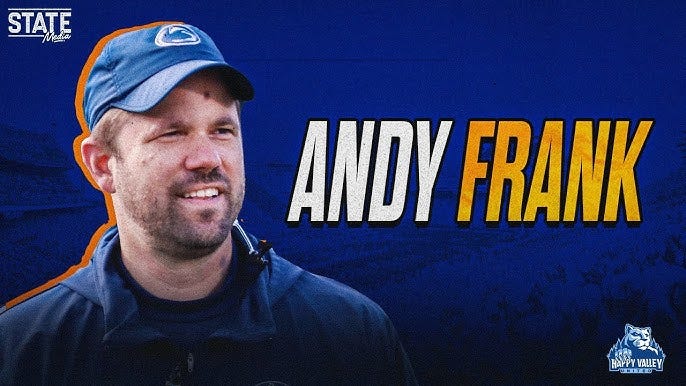The Hidden Architect Behind Penn State's Quest For A National Championship
“I think it’s important to look at it holistically and say ‘Hey, we are building a team for this year, but we’re also trying to make sure that we continue things going into the future,’” Frank said.
Welcome to Breneman Journal by Adam Breneman — a 2x per-week newsletter with analysis, hot takes, and news on all things college football, NIL, and recruiting. Subscribe now and join nearly 13,000 other sports fans, and share this newsletter with all the college football fans you know!
In this episode of “Next Up,” I sat down with the man behind the curtain at Penn State football — general manager Andy Frank.
For years, Frank has played a critical, but often unseen, role in building one of the top programs in college football.
He’s been James Franklin’s right-hand man going back to their time at Vanderbilt, and now he’s overseeing everything from roster construction and recruiting strategy to navigating the chaos of NIL, the transfer portal, and revenue sharing.
We dove deep into how a college football program is built — not just for one season, but for sustained success. Frank talked through how Penn State evaluates players, what they look for beyond size and speed, and how they balance winning now with building for the future.
Frank is one of the most thoughtful minds in the sport, and this conversation is packed with insights you won’t find anywhere else.
Without further ado, let’s jump into my favorite takeaways:
1️⃣ Be Collectively Intelligent
Given Frank’s credentials, the Nittany Lions’ general manager could be tagged as the smartest staffer throughout the Power Four ranks.
Frank graduated from Princeton in 2001 with a Bachelor of Science degree in engineering and later obtained a Master’s degree in education from Vanderbilt in 2007.
While at Princeton, he excelled as a defensive back, which ultimately propelled him to pair his analytical expertise with his love for college football in a full-time role.
After first teaming up with Franklin at Vanderbilt in 2011 as the Commodores’ player personnel coordinator, he advanced into roles leading the personnel and recruitment departments in Happy Valley, while navigating NIL and revenue generation strategies.
“You’re tied to so many different people and departments in the organization that you’re working with all of the different people to try and figure out what is the best way. It’s never one person’s job,” Frank told me. “It’s everybody’s collective job to try and put it all together.”
Per the Nittany Lions’ directory, Franklin’s comprehensive staff is 54 people deep, with Frank, Dann Kabala, Jordan Hill, Kenny Sanders, and others all helping to propel Penn State into the sport’s newly professionalized era.
While Frank is extremely intelligent in his own right, he thinks the collective brainpower of his teammates can be more dynamic than any other “front office” department nationally.
“I think we spend probably too much time, maybe as a culture, thinking about, ‘Hey, who’s the smartest guy in the room, or who’s the star, who’s the genius?’” Frank told me. “You put a collective group of people in the room, [and] the room should be smarter than whoever the smartest person is in the room.”
This newsletter is presented by... PrizePicks
PrizePicks is the easiest way to play daily fantasy. Getting started is very simple — register for an account, make a deposit, and pick more or less on 2-6 player stats to win payouts of up to 25x!
This season, place a $5 lineup, and use code “AdamB” to instantly earn $50 in bonus bets. Click on the link below to get started today!
2️⃣ Cover All Bases
In light of the recent House v. NCAA settlement, each Power Four institution is expected to share 22% of its athletic revenue with its athletes beginning in July.
While the projected cap is hinted to be around $20.5 million, nothing is set in stone, just months before projected implementation.
Schools are allowed to distribute the revenue “however they see fit,” according to Sports Illustrated, which could allow 90% of shared revenue to stay within football and men’s basketball programs to promote long-term athletic department growth.
Frank and his team have worked tirelessly on piecing together contingency plans through “What If Analysis” to best position Penn State when the NCAA levies its final ruling.
“It’s interesting, because I don’t think we know exactly what it’s going to look like in terms of, ‘These are the exact rules,’” Frank said on revenue sharing. “You wish you knew this was the game that you’re playing.”
“So right now, you’re putting together several different contingencies,” he continued. “‘Hey, if there’s a salary cap, and it functions this way, this is how we’re going to operate. If there’s a version of the salary cap, and it gets litigated, and maybe it’s not quite as fully stringent on this is the cap, this is how we’re going to operate.”
For the Nittany Lions’ program, Frank is attempting to utilize as many resources as possible to keep Penn State at the forefront of NIL and revenue sharing maximization, all while remaining realistic throughout the process.
“You have to function, in today’s world, planning as if both could potentially be possible, and try to make sure you stay within the limits of where you think it could be,” Frank said. “While, at the same time, [you are] trying to stretch those limits in case there are more resources available.”
🔥 New FREE Resources for Athletes
The #1 question I get asked in my DMs is:
“How do aspiring college athletes get noticed by college coaches or scouts?”
So, I just launched a new video training called the Get Coaches to Call Gameplan.
Inside I reveal ALL the secrets that top recruits use to get noticed at the elite D1 programs!
Any athlete, parent, or coach can use this to get ahead of the competition.
3️⃣ Build A Program, Not A Team
When I spoke with Franklin during my visit to Happy Valley, the veteran head coach talked about how every player on his roster is “likely walking away from a little bit of money” by deciding to play for Penn State.
However, in today’s model dominated by large-scale, individualized NIL offers, Franklin and Frank both agree that keeping the collective team on the same page far outweighs individual monetary maximization.
From there, it’s far easier to establish a culture of continuity and generate annual success, rather than simply having shorter pockets to win big.
“Not only are you building a team, you’re building a program,” Frank told me. “In today’s world, you could look at it from a standpoint of ‘Hey, we’re just building a team for this coming year, and you can make decisions that might hurt yourself down the line.”
“I think it’s important to look at it holistically and say ‘Hey, we are building a team for this year, but we’re also trying to make sure that we continue things going into the future,’” Frank added.
Frank reiterated that Penn State’s football culture consists of far more than compiling wins on the field.
It’s bigger than the game itself — it’s about working hard in the classroom, fostering positivity within the community, and growing socially and spiritually to achieve long-term success off the gridiron.
“If [a recruit’s decision] is just purely about football, it’s probably not the place for them, because we’re going to have expectations for them in the classroom,” Frank said. “We’re going to have expectations for them in the community that if they just want to do it on the football field, it’s probably not going to work so well.”
To watch my full conversation with Frank, click here.
If you have any questions, comments, or feedback, please don’t hesitate to reach out to me by email at adam@brenemanmedia.com.
You can also find me on Twitter, Instagram, TikTok, LinkedIn or Facebook.
Shoutout to Connor Krause for helping to write this newsletter and putting it together!
Interested in advertising with Breneman Journal? Email me.











